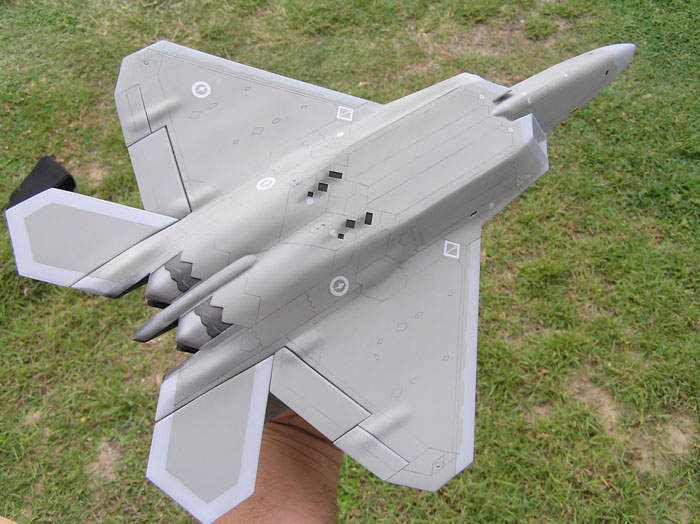This is Italeri's F-22. As
everyone knows who frequents this site should know, this kit is a
right pig to build. This is my second Italeri Raptor - you would
think that I would have learnt the first time!
I built this over the course of 18
months. The kit was built using the Eduard Brass etched set which
gives the cockpit a big lift, even though you can't really see much
of it through the closed canopy!
I started by gluing the forward and
aft upper fuselage together. This is not a good joint and causes a
large dip in the middle of the jets back. Super glue in large
amounts corrected this problem. After the glue had dried I re
scribed & corrected the panel lines. After this I closed the weapons
bays, gun door, APU doors, landing gear doors, and secondary intakes
by gluing the kit parts in place. They do not fit very well at all!
A lot of super glue & putty was applied and more re-scribing was
done. This was by far the most painful part of building the kit. I
then cut out the vents and replaced them with the brass parts from
the Eduard set.

The intake parts were fitted and I
glued in some plastic card to close in intakes to prevent the see
through. The exhaust parts were glued in place and the exhaust parts
from the Brass parts were fitted. The exhaust was painted with
Testor's Titanium Metalizer and the upper and lower fuselage were
brought together.
The cockpit had the Brass components
fitted for the side panels and instruments with acetate behind them.
The pilot was robbed from a Hasegawa F-4 kit and his helmet was
modified to current style. I cut off his arms and re-positioned them
by cutting at his elbows and shoulders. I then drilled into the
middle of the separated parts and inserted wire into them. This
allowed me to move the arms into the positions holding the side
stick and throttle. The cut areas were filled with Milliput and
reshaped to match the rest of his flying suit. The oxygen hose was
also replaced with guitar string. He was glued onto his seat and
strapped in with a Tamiya tape harness. I made the buckles from
leftover parts of the photo-etched set.
The canopy was painted with Tamiya
Clear yellow mixed with a little clear orange. This was then mixed
50/50 with Tamiya gloss clear. I sprayed this carefully over a spare
canopy that I had from my previous build. After a few attempts I was
happy with the results and painted the good kit canopy. After a week
to cure, I dipped the canopy in future to fill any little
imperfections. The canopy frame was glued to the upper fuselage and
was super glued and sanded until it aligned with the surrounding
area.
The cockpit was the added from below
the fuselage and glued in place. The lower forward fuselage was then
fitted and the gaps filled.
 I
masked the exhausts and painted them with a mixture of Testor's
Metalizers.
I
masked the exhausts and painted them with a mixture of Testor's
Metalizers.
Then the exhausts were masked and
the rest of the fuselage was painted with Xtracolour Modern Eagle
colours in freehand with some panels masked and painted in Model
Master Light Ghost Gray.
The vents were picked out in Flat
Black. I had custom decals printed for the kit in RAAF 3 Squadron
markings by a company near me. I think they came out well. These
were added along with some of the kit decals. The decals were added
using Future as a setting solution.

The whole model was then coated in
future and after drying, a black wash was run into the panel lines.
I then used pastel chalks to put some exhaust & cordite stains where
they were needed to make this Raptor look used.
I used Humbrol Mattcote for the
final mate finish.
The
finishing touch was the addition of the tinted canopy and HUD glass.
I think that with a bit of
work and a lot of elbow grease, this kit comes out pretty well. It
looks like a Raptor to me, and it's Aussie which makes it even
better :-) .
My Raptor is now with her new owner
and has even had a
starring role
in the Australian Airpower website!
Cheers.
Home
| What's New |
Features |
Gallery |
Reviews |
Reference |
Forum |
Search